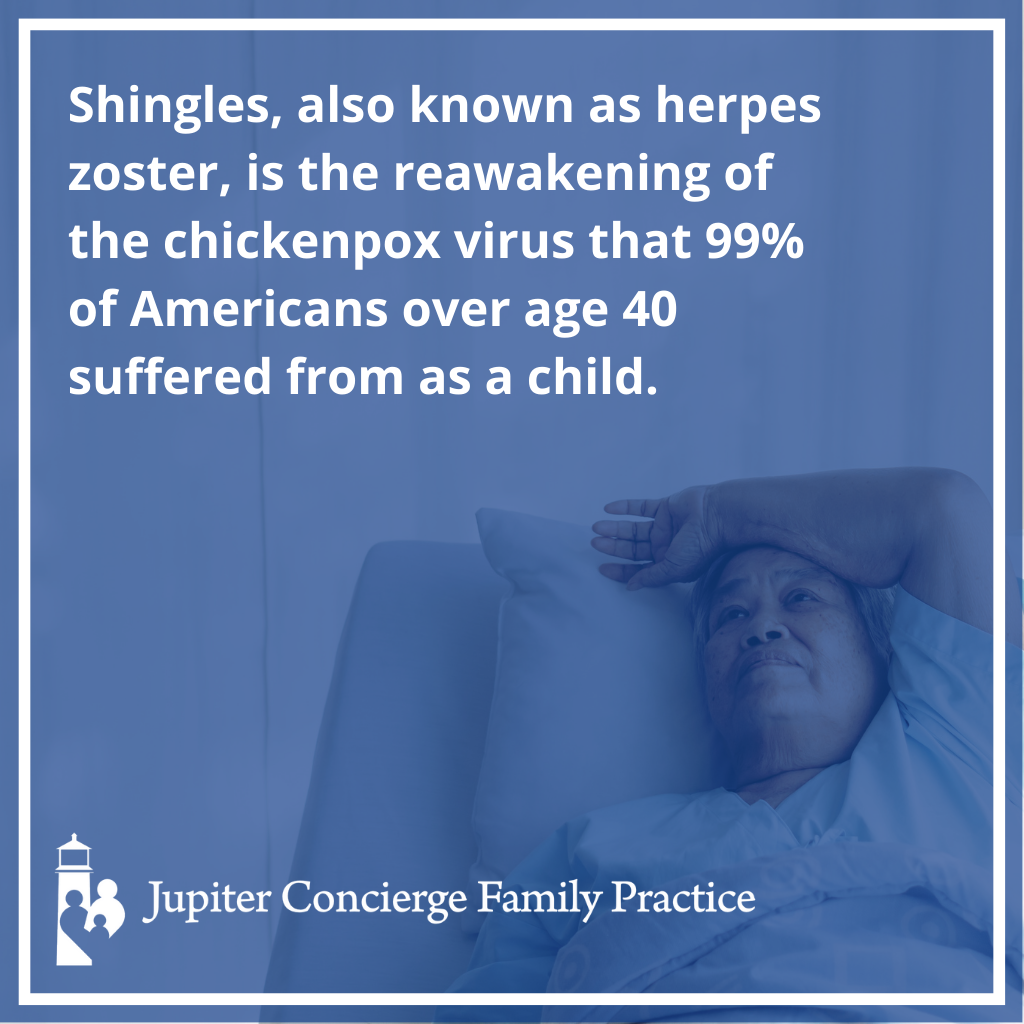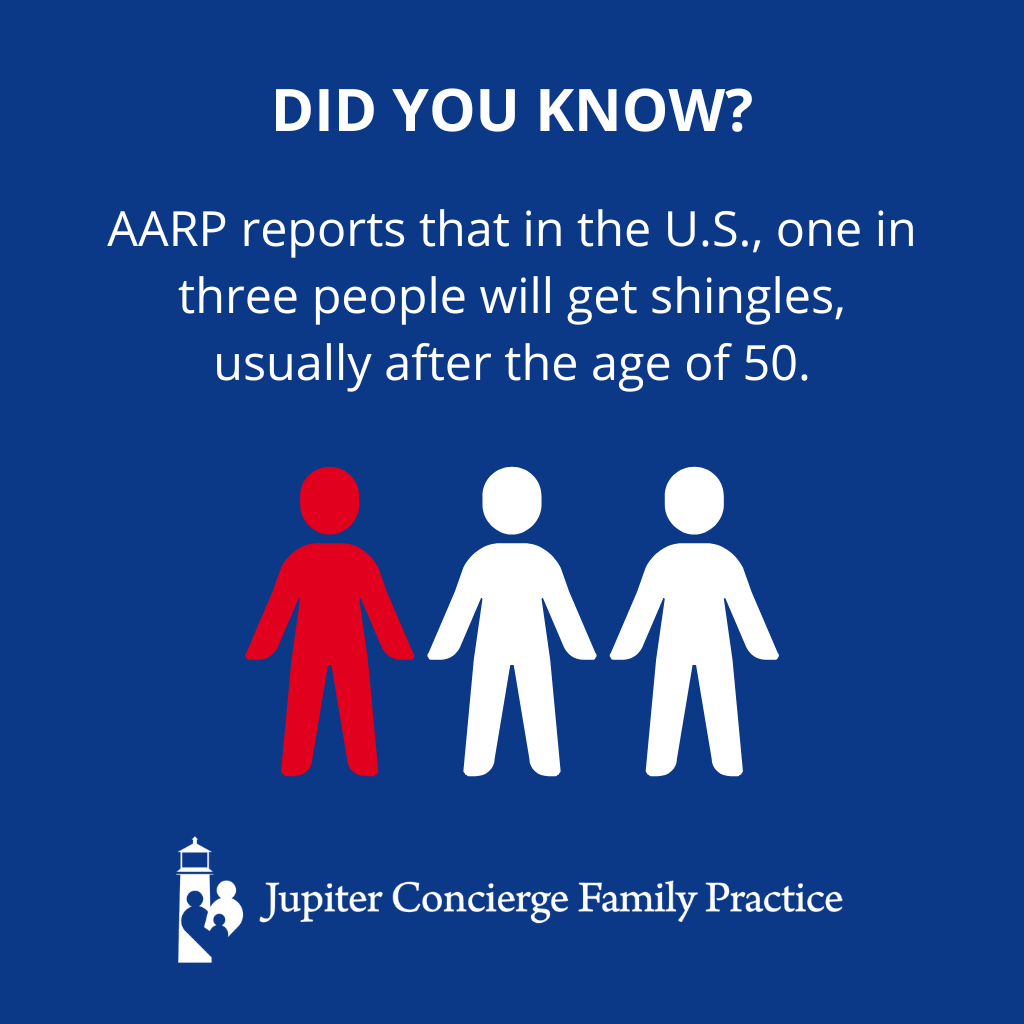
Just about everyone knows someone who’s had shingles. In fact, AARP reports that in the U.S., one in three people will get shingles, usually after the age of 50.
Risk of developing complications from the disease increases abruptly after age 60. And since the risk of developing shingles steadily climbs with age, about half of people who live to be 85 will experience it at least once.
If you know someone who’s had shingles, you know it’s an unpleasant, painful disease you really don’t want to get. But what exactly is shingles? How serious is the disease, and what are its long-term consequences?
Shingles, Explained
Shingles, also known as herpes zoster, is the reawakening of the chickenpox virus that 99% of Americans over age 40 suffered from as a child.
Unlike many other viruses, like the ones that cause colds, the chickenpox virus doesn’t leave your body when your immune system gets the illness under control. Instead, the virus retreats and lives in a dormant state within nerves at a certain level of your spinal column. If your immune system becomes weakened or compromised, the virus awakens, this time to cause shingles.
As the virus reemerges, it travels along the nearby nerve root, creating a one-sided blistery, painful stripe on your skin. The location of the rash varies, depending on where in the spinal column the virus was lurking.
In its earliest stage, shingles isn’t visible but causes the skin to become very sensitive and painful. Then the rash appears. Except in very mild cases, the rash blisters within days, and the blisters break open and crust over and begin to heal after a week or two. Healing can take one to three weeks.
If you’re unfortunate enough to experience a shingles outbreak, it must be treated within 48–72 hours. After that time period, antiviral medications will no longer be effective against the underlying cause and treatments can only address symptoms.
Unfortunately, shingles pain remains present throughout each stage of the disease, though it gradually improves during the healing process. Most healthy people are back to normal in a month or so.
Shingles Complications
In the best-case scenario, shingles heals up and normal life resumes, leaving behind only bad memories. Unfortunately, that’s not always what happens.
Somewhere between 10–20% of shingles sufferers develop pain that endures long past the conclusion of their shingles outbreak. This pain, called postherpetic neuralgia, can last for months or even years and stems from the shingles virus’s damage to your nerve fibers.
Postherpetic neuralgia is simply the medical way of saying nerve pain following a herpes infection. (Though not widely known, the virus that causes chickenpox and shingles is a form of herpes virus called varicella-zoster.) Age, a weak immune system, and delayed treatment all increase a person’s risk of developing this complication.
Postherpetic neuralgia can be extremely painful, even debilitating. The affected areas become exquisitely tender. Clothing, sheets, or even a light touch on the skin can be intolerable. As you can imagine, such a condition can devastate normal life, causing all kinds of problems, including poor sleep and depression.
Less commonly, shingles outbreaks on the face can also pose long-term problems. If the shingles virus emerges via nerves near the head, the rash can spread to a person’s eye, causing severe pain and potentially leading to postherpetic neuralgia in the eye, impaired vision, or blindness. Prompt treatment of ophthalmic shingles can help avoid these complications.
How the Newest Shingles Vaccine Makes a Difference
In the past, we had little to defend against the possibility of a shingles outbreak. However, in 2006 the FDA authorized the first shingles vaccine, Zostavax, which reduced the risk of developing shingles by 51% and the risk of developing postherpetic neuralgia if you did develop shingles by 67%.
While Zostavax represented a step forward, today we have an even more effective vaccine called Shingrix. This newer vaccine is extremely effective — over 90% — at preventing both shingles and postherpetic neuralgia.
The vaccine is a two-shot series, with the second shot given between two and six months after the first, and can prevent life-altering complications from shingles, not to mention the painful illness itself.
Who Should Get the Shingles Vaccine?
So, who should get the more recent shingles vaccine? As part of a plan to stay healthy after 50, people aged 50–60 should get the vaccine. People younger than age 50 who live with chronic illnesses or who are immunocompromised should also talk with their physician about getting the vaccine.
Remember that shingles is the reemergence of the chickenpox virus, so only people who have had chickenpox in the past need the shingles vaccine. However, nearly all American adults born before 1980 have had chickenpox, even if they don’t remember it.
If you’re one of the rare adults who has never had chickenpox, you don’t need a shingles vaccine — but you do need a chickenpox vaccine.
Does the Shingles Vaccine Have Side Effects?
As with any medication or vaccine, there’s always the possibility of an allergic reaction to Shingrix, though rare. Typically, however, side effects are quite mild.
When you receive the shingles vaccine, you may experience soreness in your arm at the injection site and perhaps some flu-like symptoms for a day or two. These symptoms are self-limiting and don’t cause any lasting illness.
In light of the potential complications of shingles, a day or two of mild discomfort is a small price to pay to avoid this painful illness.

Dr. David Rosenberg
Dr. Rosenberg is a board-certified Family Physician. He received his medical degree from the University of Miami in 1988 and completed his residency in Family Medicine at The Washington Hospital in Washington, Pennsylvania in 1991. After practicing Emergency Medicine at Palm Beach Gardens Medical Center for two years, he started private practice in Jupiter, in 1993. He is an avid baseball fan and Beatles fanatic, since he was 8 years old. He has been married to his wife, Mary, since 1985 and has three grown children.
David completed additional studies at Mercer University, Macon, Georgia and obtained a BS in Chemistry in 1983.
“My interests include tennis, snow skiing, Pilates and self-development.”


